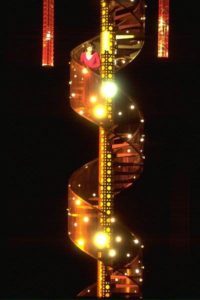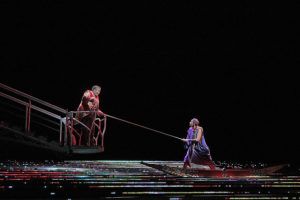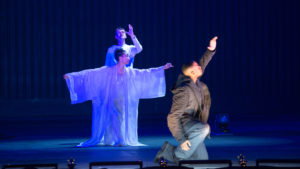There is so much emotion in music we are incapable of restraining.
***
[W]hile the production of woman comes from defect in the active force or from some material indisposition, or even from some external influence; such as that of a south wind,” wrote St. Thomas Aquinas in his Summa Theologica. If this be true, praise the moist southern winds for the birth of Kaija Saariaho, whose music – whether through weakness of active force, or through indisposition of musicological material – has been consistently eluding all analysis and seducing listeners around the world for almost thirty years.
In 2001, Nick Kimberley, critic and columnist for the influential London Independent, wrote a short preview of a monographic Saariaho concert series with the characteristic title “The Music of Dreams (and Sometimes Nightmares)”. This text is remembered chiefly for one clever formulation about “the most important Finnish export product since Nokia”. Less attention has been paid to the words of the composer herself, though she confessed to Kimberley that she recalls the majority of her dreams: “Sometimes I dream music and I can recall it when I awake. Other times I just remember its mood and color. This doesn’t mean that I write music in an unreal dream-world poetic language. Rather, I treat dreams as a gateway to concealed essences – death and love, for example – basic things of which we have no idea.”
Photo: Maarit Kytoharju.
Kaija Saariaho was born in Helsinki, on 14 October 1952. She displayed creative abilities even as a child, learning how to play several instruments, attending drawing and painting classes. Alongside her musical education, she took up studies at the capital’s Academy of Fine Arts, but soon quit to devote herself entirely to the art of composition. Her first mentor was Paavo Heininen, a Finnish dodecaphonist and post-serialist a generation older than she. In 1977, she co-founded the “Korvat auki!” [“Open Your Ears!”] artistic association with other Sibelius Academy students, including Magnus Lindberg and Esa-Pekka Salonen. Its aim was to popularize contemporary music in Finland. While her friends soon set off into the mainstream of Finnish New Wave music, Saariaho continued exploring and, after leaving the country in 1981, took up further compositional studies, attending courses in Darmstadt and at the Staatliche Hochschule für Musik in Freiburg, where she honed her skills under the watchful eyes of Brian Ferneyhough and Klaus Huber.
Only a year had passed before the composer was on her way to Paris, where she settled permanently, having finally found ideal conditions for work and creative development. At the famous IRCAM, she could devote herself entirely to researching new instrumental techniques, to computer analysis and sound synthesis, engaging in the lively discourse between Modernism and Spectralism. For all her respect for Ferneyhough and Michael Finnissy’s New Complexity, Saariaho never concealed her adoration of the work of Gérard Grisey and Tristan Murail, two icons of spectral music, co-founders of the famous Ensemble l’Itinéraire. The roots of her fascination reach deeper, however: all the way back to the work of Henri Dutilleux – imbued, on the one hand, with the spirit of Neoimpressionism; and on the other, inspired by Bartók, Stravinsky and jazz, and yet astonishingly distinct, pure and precise.
Since the end of the 1990s, Saariaho has more and more frequently been returning to purely acoustic sounds, flirting with melody, and creating atmospheric, quasi-tonal spaces – and yet, in spite of her apparent Linearism, she writes music marked first of all with color, full of the most diverse associations, including those from beyond the realm of sound. Her compositions are increasingly accessible to listeners, and increasingly hermetic to interpreters of music.
Dawn Upshaw as Clémence in the Peter Sellars’ production of L’Amour de loin, Théâtre du Châtelet, Paris, 2001. Photo: Marie-Noelle Robert.
To give a work a credible analysis, one must first establish its point of departure, establish its conclusion, distinguish its various phrases, contrasts and culminations. But it is precisely these that are most difficult to isolate in the works of Saariaho, who avoids clear gestures and sharp contours, focusing on what goes on inside, between sounds, on the level of timbre and sonorities. In daydreaming, she opens the gate to other worlds, trying to reveal new and intangible dimensions that elude hard analytic rules. It is difficult to evaluate and categorize the œuvre of a composer who does not for a moment think of “evolving”: in this œuvre, there are neither “juvenile” nor “mature” compositions. Nymphéa, written in 1987 for string quartet and electronics, sounds just as fresh and compelling as Terra Memoria from 2006 – for the same instruments, just minus the electronics. In the former work, Saariaho seeks new colors, weaves sound masses into structures delicate as silk, creates the musical image of a water lily in the most diverse dimensions – from monochromatic wave forms to colorful planes. In the latter work, she stresses the linearity of the composition, which is dedicated to those who have passed away. Some elements – like the memories that haunt our dreams – remain unchanged. The rest of the sound material undergoes constant modification, colliding, vanishing, only to resurface seconds later, just like the illusory memory of the dead, who, after their demise, start to live new and unpredictable lives in the hearts of their loved ones. There is an extreme variety of techniques, a similar impression of imagery, an unbridled sonic vision and an expansive, one is tempted to say, “feminine” emotionality.
Saariaho sometimes bristles at critics’ and theorists’ constant drawing of attention to the coloristic aspects of her music. She accuses them of superficial analysis, reminding them that color and sound are the most obvious, the most “audible” aspects of a composition – beneath which, however, is hidden a complex tangle of other meanings, such as the tension that builds between sound and background noise. Shifts in intensity of sound, therefore, serve less to modify the coloristic values of a work than to build a peculiar form – one based on significantly subtler and more elusive principles than traditional resolutions of harmonic dissonances into consonances. It is no wonder that Saariaho takes such pleasure in writing for the human voice, as well as for the flute and the ’cello – instruments whose wealth of sound permits the erecting of structures that are mighty and powerful, but at the same time subtle and mysterious, like the network of ionic bonds in a crystal.
Eric Owens (Jaufre Rudel) and Tamara Mumford (Pilgrim). Robert Lepage’s production of L’Amour de loin at the Met Opera, 2016. Photo: Ken Howard.
In Laconisme de l’aile of 1982, a work for reciting flutist, the tension between the transparent sound of the instrument and the raw sound of the human voice evokes the suggestive feeling of a bird in flight. In Près for ’cello and electronics, written ten years later at the IRCAM studios, the “pure” sounds of the ’cello create an increasingly dense mixture with sounds synthesized on a computer, bringing to mind the swoosh of the surf, the tranquil energy of rising and falling tides, the eternal rhythm of drought, rising water levels and floods. The sounds used by Saariaho give her work the traits of peculiar Neoimpressionism: in lieu of the uniform, garish colors of individual instrumental sections, the composer introduces broken shades of musical whites, grays and browns, voices “dirtied” with electronics, sounds muffled by background noises, tones covered with a glaze of silence.
In her latest compositions, Saariaho tries to make us understand that all divisions into vocal, instrumental and electronic planes miss the mark. The medium retires to the background, what become most important is the message, rendered so suggestively that the listener ceases to pay attention to the source of the sound and its physical attributes, and instead begins to explore its taste, color and smell. The composer leads us into unknown worlds, full of mysteries and violent, often ambiguous emotions. The vibrating polyphony of two hearts beating in a different rhythm in Je sens un deuxième cœur from 2003 is a reflection of the joyous expectations of a pregnant woman who recognizes the pulse of a growing fetus growing inside her body. The spastic, stifled “I am, I am, I am” in From the Grammar of Dreams is, in turn, the despairing conclusion of would-be and future suicide Sylvia Plath, author of The Bell Jar, who listens to the rhythm of her own heart and in terror repeats “I am”, though she would so much prefer not “to be”. The same topos of the beating heart, completely different sentiments: fear and hope, tenderness and revulsion.
The world premiere of Only the Sound Remains, directed by Peter Sellars. Philippe Jaroussky (Tennin/Angel), Davone Tines (Fisherman), and Nora Kimball-Mentzos (Dance). De Nationale Opera Amsterdam, 2016. Photo: Ruth Walz.
The eternal motifs of death, love, solitude, intimacy and the passage of time have found their fullest expression in Saariaho’s operatic œuvre, beginning with the famous L’Amour de loin from 2000 – for some, the tale of a troubadour, a princess and a pilgrim; for others, a treatise on happiness, imagination and melancholy. In this vast ocean of orchestral colors and orientalized vocal melismas, one hears the influence of Debussy – the remote echoes of his Pelléas et Mélisande; and yet, the devices the composer uses to build her Neoimpressionism hail from the arsenal of the latest achievements in sound technologies – from the mighty power of the Macintosh computer to the eight-octave MIDI keyboard, and concluding with sophisticated software. In her subsequent theatrical efforts (Adriana Mater from 2005 and Émilie from 2008), Saariaho abandoned electronics in favor of a more restless vocal/instrumental texture. In both operas, she resolved to plumb the depths of female longings, fears and frustrations. Adriana Mater is the story of a raped woman who brings up her child, torn between maternal love and hatred toward her assailant – in the music, the emotions grow little by little, emerging from a web of ’cello glissandi, a choral lament devoid of words, and percussion interventions that swell like an ulcer. The epistolary Émilie is a monodrama of the Marquise du Châtelet, a beautiful and brilliant woman, one of the creators of the principle of conservation of energy and author of the formula for kinetic energy. At the same time, she was a lover of many wealthy, influential and outstanding men of her era. Economy of means and transparency of texture all the more clearly reflect the drama of a lonely woman isolated from the world of men, who completed her translation of Newton’s Philosophiae naturalis principia mathematica a few days before giving birth and then died in labor. The motif of pregnancy and fear of the “alien” in one’s own body continually recurs in the work of Saariaho, who is herself the mother of two children.
This split, so peculiar to men, appears throughout the life and work of this Finnish composer, who once impressed Krzysztof Kwiatkowski as a pessimist who does not lose hope. Saariaho never believed in the success of the “Korvat auki!” association and continues to be surprised by the fruits of its activities. Saariaho never supposed that someone would compare her with Nokia’s product line. Saariaho is incapable of shutting her eyes and ears to the atrocities of this world, and is continually afraid that the music she has created will soon lose its raison d’être. I suspect that she must sometimes feel like the protagonist of her fellow countrywoman Tove Jansson’s Moominland Winter, who suddenly awoke from hibernation and noticed that “the valley was not green, only white. Everything that had once moved was motionless. All living sounds had fallen silent. Everything that was angular had become round.”
If Saariaho should awake one day in such a world, I hope she will act like Moomin, who “walked onward, leaving the first tracks on the bridge, and further, on the mountain slope. These were very small tracks that led straight between the trees, to the south.” In the right direction – to where the moist wind blows.
Translated by: Karol Thornton-Remiszewski




